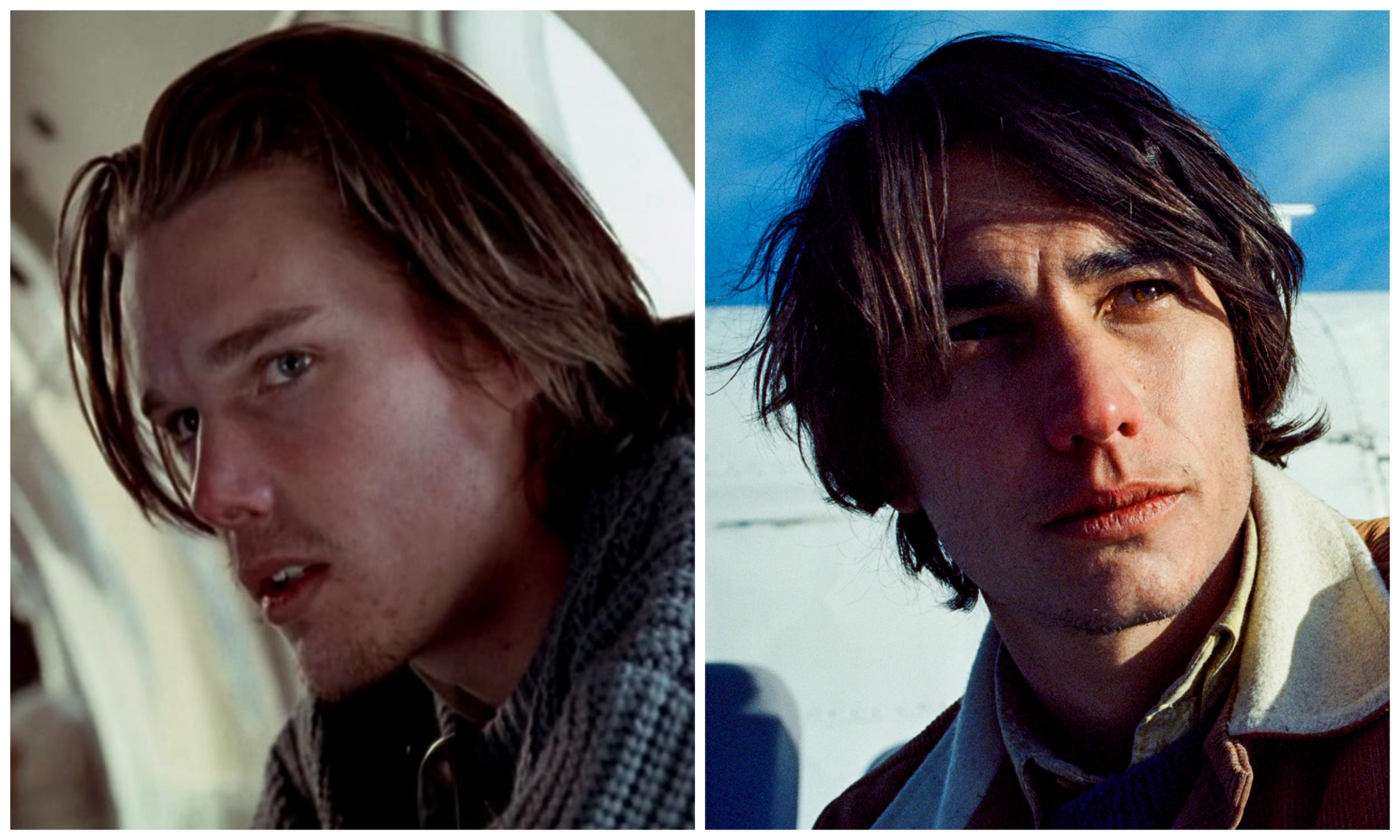
This article contains Society of the Snow spoilers.
Newly arrived on Netflix after a brief theatrical run, is director and co-writer J.A. Bayona’s Society of the Snow. The film recounts the tragic, but incredible, story of Uruguayan Air Force Flight 571, which crashed on a remote mountain in the Andes during a routine flight between Uruguay and Chile. The flight was carrying a total of 45 passengers and crew, including the members of Uruguay’s Old Christians rugby club, plus assorted family and friends.
Some 16 people died either in the crash or its initial aftermath while 13 more perished during the more than two months in which the 29 initial survivors tried to stay alive in frigid temperatures with no food and a number of grave injuries. During that time—long after search-and-rescue missions were called off—the survivors resorted to eating the flesh of their dead companions to nourish themselves. Eventually, two members of their party walked nearly 40 miles out of the Andes during a thaw to eventually find help.
The story of how the survivors stayed alive made headlines around the world when it first broke. There was initially a media frenzy and backlash when the truth came out, but the public shock and even outrage dissipated as the details emerged—and as the “sacrifice” of the dead was compared in some quarters to Christ offering his body up at the Last Supper. “I feel that I shared a piece of my friends not only materially but spiritually, because their will to live was transmitted to us through their flesh,” survivor Roberto Canessa told National Geographic years later.
Naturally, the “Miracle of the Andes” was prime feature film material, and Society of the Snow is not the first or even the second filmed version of the story. The first, 1976’s Survive!, was a Mexican production directed by Rene Cardona, best known for exploitation cheapies like Night of the Bloody Apes. Survive! does play like a low-rent shockfest, with primitive visual effects, atrocious dubbing, and an emphasis on gore. Hollywood, meanwhile, picked up the story in 1993 when Touchstone Pictures adapted Alive from a nonfiction book of the same name by Piers Paul Read. Directed by Frank Marshall (Arachnophobia), the movie stars Ethan Hawke, Josh Hamilton, and a largely white cast as the plane’s passengers. A modest hit at the box office, the film has that slick veneer that only a Hollywood studio can provide, but has nevertheless stood for 30 years as the major cinematic telling of the story.
With this in mind, let’s compare Alive and Society of the Snow and see how they’re different, how they’re alike, and whether one is better than the other.
Hollywood Opening vs. A Spiritual Framing Device
For the most part, Alive and Society of the Snow accurately tell the story of Flight 571 in very similar, and in some cases almost beat-for-beat, fashion. But both make distinct narrative choices along the way: Alive opens and closes with a framing device in which John Malkovich portrays an older version of Carlitos Páez, one of the survivors who is played as a younger man by Bruce Ramsay. Carlitos offers a few words at the beginning and end of the story. It’s a fairly pointless exercise that adds nothing of substance to the narrative. Malkovich even literally says, “I have nothing more to say” at the end of the film. So the real story begins immediately afterward, with Marshall putting us right on the plane minutes before it crashes.
Society of the Snow has a more poetic framing device, but one that arguably makes even less sense. The story is narrated in voiceover by a character who actually dies two-thirds of the way through the picture (Enzo Vogrincic’s Numa Turcatti). As the film goes on it emphasizes a spiritual component via Numa’s ghostly sacrifice, but it doesn’t quite land. Society also begins on the ground, showing a few snippets of the team members and other passengers preparing to depart, before getting onto the plane as well.
From there, the major events of the story—the crash, the initial attempts to survive and ration out what little food they have, the missions to find the plane’s tail section and retrieve a radio battery, the decision to eat the dead, the terrifying avalanche that took the lives of nearly half the remaining survivors, and the final walk by Canessa and Nando Parrado—occur in both films in pretty much the exact same sequence. Some details are altered or compressed along the way, but the main narrative is the same.
An Adventure Story vs. A Gritty Tale of Survival
Frank Marshall has been primarily a producer for most of his career—as co-founder of Amblin Entertainment with his wife, Kathleen Kennedy, and Steven Spielberg, as well as through his and Kennedy’s own production company—and he has been behind some of the biggest hits of the past 50 years. He’s also directed four features (and a handful of documentaries), including Alive, and while his direction on this film is competent, it’s also fairly workmanlike.
Much of Alive is lit and shot a bit like a TV movie: even material that should be darker (like the interior of the wrecked plane) is generally too brightly lit. Marshall does create a real sense of terror during the crash (even with 30-year-old visual effects) and the avalanche, and he and DP Peter James do pull off a lot of wide, often striking location shots (the film was mostly lensed in a mountain range in British Columbia, Canada). But his overall tone and aesthetic is that of an adventure movie, complete with a bombastic score from James Newton Howard. And honestly, this choice is at odds with the material.
Bayona, on the other hand, began his directing career with a genuinely frightening horror film (the Guillermo del Toro-produced The Orphanage) and scored a box office and critical hit in 2012 with The Impossible, the incredible story of a family who survived the 2004 Indian Ocean tsunami (his subsequent films, the fantasy A Monster Calls and the franchise placeholder Jurassic World: Fallen Kingdom, are far less creatively successful although the latter was of course a hit).
The director seems to be in his element with survival stories, as Society of the Snow is his best effort since The Impossible. It’s also better directed than Marshall’s version of the Flight 571 story. More moodily shot and scored by Michael Giacchino, Society is technically and perhaps emotionally more powerful. It’s a darker, grittier, and more realistic version of the events (mostly filmed in Spain, with some actual location shooting in Uruguay, Chile, Argentina, and the real crash site in the Andes), with less of that Hollywood gloss that Marshall and Disney brought to the proceedings in 1993.
The Cast and Characters
This is where both films are beset with severe problems. Alive, however, has a major issue right off the bat: this is an almost completely whitewashed and Americanized version of the story, with American and Canadian actors playing the bulk of the main cast. Just about everyone on the plane was of Uruguayan or otherwise South American descent, but you’d never know by watching actors like Ethan Hawke and Josh Hamilton, who play the central characters of Nando Parrado and Roberto Canessa. With little to inform us of their culture or ethnic backgrounds, and almost nothing in the way of accurate accents, you wouldn’t even really know that most of these people are South American if the movie itself didn’t tell us.
Bayona’s film course corrects this in a big way. The entire cast is made up of mostly Uruguayan and some Argentinian actors, many of them new faces or relatively unknown. This adds a tremendous amount of verisimilitude to the film. It’s harder to swallow Hawke in the main role, for instance. The dialogue is also spoken in Spanish, and while Netflix is making a dubbed version available, we tapped out of that after just a few minutes when we realized we had accidentally started that one first.
But as hard as the actors try in both versions—and again, the fact that the actors in Society are not widely familiar to viewers adds to their realism—both Alive and Society suffer from one major deficit: none of the characters are fleshed out in any substantial way beyond “this guy is the team captain” or “this fellow plays guitar.” Even as characters pass away over the course of the film, their names mean almost nothing, because we don’t really get any indication of who most of the survivors are.
The characters of Nando and Roberto, who eventually take on leadership roles and have most of the film’s third act to themselves, fare somewhat better (and Hawke in Alive is of course a recognizable face), but neither film’s screenplay works very hard to bring any of these characters forward in a meaningful way. They’re just one group of blurred faces (and much dirtier, malnourished ones in Society, whereas everyone still looks pretty good by the end of Alive). This blunts the emotional connection we may feel to them. Neither film solves this problem, and it remains the biggest flaw of both.
The Crash Sequence
The crash of Flight 571 is terrifying in both movies, although the seams show a bit more in Alive simply because it’s a 30-year-old production. Nevertheless, each production strives mightily to recreate the sheer horror of what happens. Alive possibly extends it a little longer, and shows people in their seats getting sucked out of the open backend of the fuselage (after the tail is sheared off) while still buckled into their seats. The loss of the tail and subsequent plunge of the fuselage down the side of the mountain happens much quicker in Society of the Snow. There’s a rough bit of green screen in Alive and a shot or two of obvious model work, and Society’s effects are far more polished.
The aftermath of the crash is handled slightly differently too. Both films show the passengers taking stock of themselves, their compatriots, and the dead while Society moves a bit faster through the nuts and bolts of the initial attempts at survival (piling up the luggage at the open end of the fuselage to keep out the cold, etc.).
As for the film’s second major catastrophe—the avalanche that buries the fuselage, killing eight more survivors in a flash—both films use nearly the exact same shot (a rapid tracking shot rushing toward the back of the fuselage, cutting to one survivor’s terrified face) to recreate what many of the survivors called the lowest moment of their entire ordeal.
An Impossible Decision
A pivotal moment in the story of the Flight 571 survivors is when they decide as a group, and with only a few declining, that in order to survive, they must eat the frozen flesh of their dead compatriots buried in the snow. In both films, the survivors debate this inside the fuselage, laying out the arguments for and against, just as it apparently played out in real life. This is mostly a group of devoutly religious people. While there is a strong spiritual component in both films, it’s slightly more prevalent in Society, yet in each case the survivors wonder out loud whether they’ll be damned for their actions before ultimately concluding that they won’t.
It is, of course, almost impossible to show the act of anthropophagy on film in a way that is (no pun intended at all) tasteful, and able to avoid appearing like a gorefest or exploitation. But both Alive and Society shy away from the reality of the act almost too much.
In Alive, we see Roberto head out to the burial site and slice a piece of what looks like frozen chicken off a small, exposed portion of the back of an unidentified victim. He hesitates before putting it in his mouth, but eventually begins to eat as others join him. The same sequence is shot with a little more distance in Society. In both films, however, once it’s established that the survivors will eat the dead, it’s largely treated in an almost offhand, matter-of-fact manner—giving us almost no insight into any psychological or emotional impact it had on those who stayed alive.
Do we need to see the gruesome reality of eating dead human bodies? That’s a different movie altogether and, since these films are based on a true story, almost certainly not an acceptable one to either the survivors or the families of the dead. But that’s why dramatizing this story is an almost impossible decision. You either plunge into the grim reality or keep such a distance that its real impact is blunted (we almost never see the survivors eating more than dried strips of indistinct flesh, whereas in real life they consumed whole bodies and internal organs).
Notably, both films have their own sort of “shock” sequence: in Alive, as Nando and Roberto prepare to hike out of the Andes, there is a brief shot of red, bloody chunks of meat being packed into rugby socks for their journey. The shot almost comes and goes before you realize what you’re looking at. In Society, as the boys are getting ready to leave the crash site once they know they’re being rescued, two of the survivors look out over a small field of discarded rib cages and bones. “What do we do with all this?” one of them asks. There is no answer.
The Ending and Aftermath
Society and Alive end very differently. In Alive, Nando and Roberto essentially crest the top of a mountain and see a green valley spread out below, indicating their emergence from the Andes. Cut back to the fuselage, and the occupants are sitting inside when they hear the sound of helicopters drawing closer. As Nando and Roberto beckon from the chopper doors, the survivors load into the helicopters and are whisked away. We see nothing of their arrival home and the film closes to aerial shots of the real crash site, as “Ave Maria” plays on the soundtrack.
Society plays this portion of the tale more accurately, as Nando and Roberto gradually make their way into a valley and eventually come to a river. Across the stream they spot a man on a horse, but since they cannot hear each other across the roar of the current, the boys get a message to him by wrapping a note around a rock and throwing it across (all of which happened). From there the boys are rescued, and there are (as mentioned above) more details about their exit from the crash site.
We also see the survivors in the hospital and reuniting with their families for a few brief moments as the narrator implores them to “keep taking care of each other.” As mentioned earlier, the actors in Society truly look like they’ve been through the ringer: filthy, bedraggled, gaunt (with a CG assist), covered in sores and scrapes. Aside from a few of the latter, the survivors in Alive don’t look like they’ve been subsisting in a frozen hell for 72 days.
In the end, neither Alive nor Society of the Snow is completely successful as a film. Both movies deflect away from any deep exploration of the psychological and spiritual questions raised by the actions of the Andes survivors, preferring to tell a mostly straight story of survival, and neither film creates a single compelling character to truly draw the audience in. Both films succeed to the extent that they do on the harrowing, almost unbelievable circumstances of the story itself, but ultimately Society of the Snow gets the edge on a technical, representative, and narrative level.
But it still leaves us wondering: why did Bayona feel the need to tell the story again without offering any substantially new angle on it? Did he simply want to recast it accurately? Was it supposed to delve deeper into the dynamics of the survivors? A better story to tell, at this point—if anyone tackles this material again in the future—would be what happened next: How the survivors dealt with returning home, the media circus that surrounded them, and the very real impact of facing themselves and the families of the dead as a result of their actions.
Society of the Snow is now streaming on Netflix.
The post Society of the Snow vs. Alive: What Are the Differences Between Andes Plane Crash Movies? appeared first on Den of Geek.





